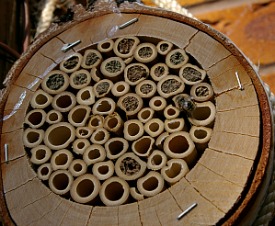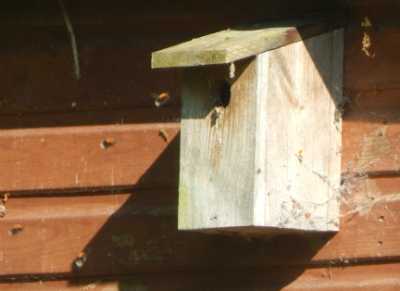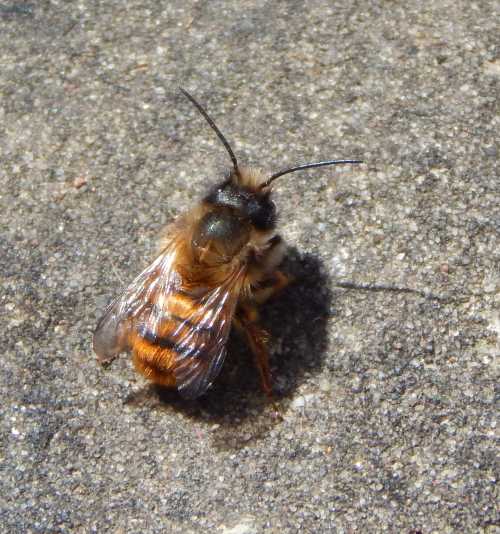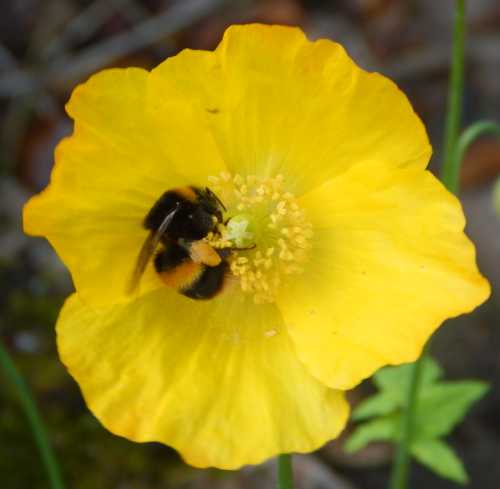Do Bee Nest Boxes Work?
Updated: 20th April 2021
As part of a general effort to help and attract bees, people sometimes consider purchasing nest boxes for bees. Indeed, for wild species, there are a variety of bumble bee nest boxes, as well as solitary bee houses available.
But you don't necessarily have to
spend a fortune. You'll see below how homes for bees can be made or purchased relatively cheaply.
On the other hand, I also think its true that a beautifully made solitary bee house makes a nice gift for a wild-life loving friend or relative, or to encourage children to observe nature.
Below is an image of a mason bee house in my garden.

I have had great success with this bee house, in particular, with mason bees inhabiting it, enabling me to film the activity. You can watch on the mason bees on this page.
This exact same log is available from Amazon US and also from Amazon UK (Disclaimer: As an Amazon Associate I may earn a small commission from qualifying purchases through links which help me fund my site).
However, some other excellent solitary bee houses are available.
With regard to shop-bought bumble bee nest nest boxes, however, the rate of success for attracting bumble bees could be disappointing.
This has was a subject of study at by Professor Goulson and team at the University of Sterling - you can read more about this report here:
http://planetearth.nerc.ac.uk/news/story.aspx?id=975 (copy and paste the link into a new window).
Anyway, here is a query I received from a visitor to my website, with my response below:
Query: For next year I would like to have a proper nest box for bumble bees. Is there such a thing? Would they use it?
My Response:
You can indeed purchase specially made bumble bee nest boxes, but they may or may not be successful. It could be that you have to wait a year or two before bees move in (if at all).
However, an untreated bird box will suffice just as well for a few species (e.g. Bombus hypnorum, and Bombus lapidarius). You can hang it from a tree as you would for a bird, perhaps put a little mesh wire over the hole to ensure bees can get in, but birds cannot.
Put some bedding in the nest box first - perhaps soft dried grass (pesticide free), hamster bedding, moss, that sort of thing. You could place a similar box more at ground level, for other species - perhaps under the garden shed, but protected from predators.
 Some bumble bees are quite happy to nest in a bird house.
Some bumble bees are quite happy to nest in a bird house.If you decide to purchase a specially designed box for bumble bees, I recommend that if there are instructions to catch and trap queens, that such instructions are ignored. I disagree with such advice. I think it is better to let bees themselves decide whether or not a site is suitable.
You may also see boxes of bumble bees for sale with a colony inhabiting the box. Again, I recommend against this, and have been raising awareness of this issue for a couple of years now.
- Originally, there was research from the USA about potential problems,
- but there is now more recent UK research too.
Basically, even when the species are native,
commercially reared bumble bees could spread diseases to wild bees. I'm not aware of this situation having changed (2017).
However, I certainly recommend you
site a solitary bee house. These can be
made from hollow canes very easily, cut to length, or you can purchase
them. As well as the shop-bought mason
bee house that is in my garden, I also have lengths of hollow cane too (bundled together),
and these also attract bees.
One of the key things you can do, of course, is ensure there are lots of plants in your garden for bees! Lots of resources here if you need them.


